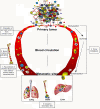The microenvironment in breast cancer progression: biology and implications for treatment
- PMID: 22078026
- PMCID: PMC3326543
- DOI: 10.1186/bcr2912
The microenvironment in breast cancer progression: biology and implications for treatment
Abstract
Breast cancer comprises a heterogeneous group of malignancies derived from the ductal epithelium. The microenvironment of these cancers is now recognized as a critical participant in tumor progression and therapeutic responses. Recent data demonstrate significant gene expression and epigenetic alterations in cells composing the microenvironment during disease progression, which can be explored as biomarkers and targets for therapy. Indeed, gene expression signatures derived from tumor stroma have been linked to clinical outcomes. There is increasing interest in translating our current understanding of the tumor microenvironment to the development of novel therapies.
Figures



References
-
- Howlett AR, Bissell MJ. The influence of tissue microenvironment (stroma and extracellular matrix) on the development and function of mammary epithelium. Epithelial Cell Biol. 1993;2:79–89. - PubMed
-
- Petersen OW, Ronnov-Jessen L, Howlett AR, Bissell MJ. Interaction with basement membrane serves to rapidly distinguish growth and differentiation pattern of normal and malignant human breast epithelial cells. Proc Natl Acad Sci USA. 1992;89:9064–9068. doi: 10.1073/pnas.89.19.9064. A published erratum appears in Proc Natl Acad Sci USA 1993, 90:2556. - DOI - PMC - PubMed
Publication types
MeSH terms
Substances
Grants and funding
LinkOut - more resources
Full Text Sources
Other Literature Sources
Medical

